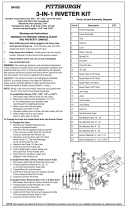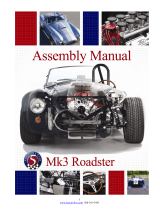Page is loading ...

Clamp Bracket
Lock-Rod Striker
Brackets (2)
Important installation information
IMPORTANT!
Keep an eye out for these icons:
Normal install time
75 minutes
Tips to assist installation
Helpful Hints
PARTS INCLUDED:
CONTINUED ON REVERSE >
1/8" Hex
Key
Threaded Insert
Installation Tool
Cap
Clamps (2)
× 2
1/4" Rivet
Nuts (12)
× 12
1/4" Self-Drilling
Screws (8)
× 8
1/4" Hex
Bolts (12)
× 12
1/4" Plain
Washers (12)
× 12
180 Cover
Gas
Springs (4)
TOOLS REQUIRED: PRE-INSTALLATION
NOTE:
If your truck has bed rail caps,
you should affix the included
bulkhead prep kit prior to
installing the DiamondBack 180.
PREPARE THE BULKHEAD
1
Attach the clamp bracket to the bulkhead, centered side to side,
flush with the top rail, and longer leg down using a drill, 3/8" nut driver
bit, and four self-drilling screws.
Installing the clamp bracket is easiest if you pre-drill it using
the screws.
Detach all three brackets by removing the self-drilling screws.
3
Use the holes in the truck body
left by the self-drilling screws
as pilot holes to drill larger,
3/8" holes.
4
Insert the installation-tool mandrel into a rivet nut. Hand-tighten
it until its hexagonal sleeve is tight to the face of the rivet nut.
6
Remove the installation tool by unscrewing the mandrel.
8
You’ll know the rivet
nut is fully com-
pressed when you
feel the mandrel
become very difficult
to turn.
Use a 9/16" wrench to hold the installation-tool
sleeve as you tighten the mandrel with a 7/16"
socket until the rivet nut deforms and locks
against the interior of the bed wall.
7
Hammer a rivet nut into each hole.
5
Do not install rivet nuts through plastic bed rail caps or plastic
bedliners. (Spray-on bedliners are fine.) Use a utility knife to
trim the plastic so that the rivet nuts’ outer flange can sit
tightly against the body of the truck itself.
Do not overtighten the bolts or you might strip the rivet nuts.
Reinstall all three brackets using
the hex bolts, plain washers, and a
7/16" socket.
10
If you are also installing a Cross Bin, do so now. Refer to page 2 of
the Cross Bin Installation Guide for details.
11
Attach a lock-rod striker bracket to each front corner of the cargo
bed, the bracket’s V bend pointing rearward and the side flange
located as high as possible without it breaking the plane of the top
of the bed rail, using a drill, 3/8" nut driver bit, two self-drilling
screws, and the two slots nearest the ends of the bracket.
2
Repeat steps 6-8 for each rivet nut.
9
Marker
9/16"
Socket
7/ 16"
Socket
Ratchet
Wrench
Hammer
9/16"
Wrench
Drill
3/8" Nut
Driver
3/8" Bit
INSTALLATION GUIDE
CVR-180.1
DiamondBackCovers.com / 800 935 4002
270
180

MAY 2017
DiamondBackCovers.com
OCTOBER 2018
To get the weatherstrip compression necessary for its adhesive to
cure and for the cover to keep out the weather, have a second
person press down on the cover while you’re adjusting the lock rods.
If there isn’t enough travel in the forward rod guide bracket to
position the rod so that it presses against the striker, reshape
the striker’s V bend with pliers.
ATTACH THE GAS SPRINGS
To avoid premature failure of your gas springs, attach them barrel up, shaft down.
Attach the gas springs to the ball studs.
25
Leave the cover closed and locked for 24 hours to allow the weatherstrip
adhesive, which is pressure-sensitive, to fully cure.
26
Adhesive cure time
24 hours
Position the lock rods tight
against the underside of the
striker brackets (forward) and
T-panel gutter (rearward) so
that they draw the
panels down and
compress the
perimeter weather-
strip. Tighten the rod
guide brackets with a
7/16" socket.
1/8" hex key
Adjust the length of the lock rods & retighten the set screws so that:
A. with the lock handle in the open position, the rod tips clear the
striker brackets,
B. with the handle in the closed position, the rod tips do not strike
the bulkhead, and
C. the rods point downward.
7/16" socket
You can leave your rearward
lock rods alone. They come
pre-adjusted from the factory.
Operating the access panels is easiest when
you press down as you open or close them.
Use the 1/8" hex key to loosen
the set screws on the linkages
of the forward lock rods.
21
22
23
Double-check both panels to ensure they open, close, lock & seal
correctly. If at any point the weatherstrip does not touch the bed
rails, readjust the lock rods and mounting brackets as needed.
24
ADJUST THE LOCK RODS
Attach the front of the cover to
the clamp bracket using the
cap clamps.
19
Repeat steps 5–8 to insert
rivet nuts into each hole.
17
Repeat step 12.
18
Drill the marks using a 3/8" bit.
16
Remove the cover.
15
To get the weatherstrip compression necessary for its adhesive
to cure and for the cover to keep out the weather, have a second
person press down on the rear of the cover while you’re attaching
the mounting brackets.
At rear, insert a hex bolt through a plain
washer, through each bracket slot, and into
each rivet nut. Tighten with a 7/16" socket.
20
MOUNT THE COVER
Close the tailgate. Place the cover onto the cargo bed so that the
weatherstrip along the cover’s rear angle is firmly compressed
against the inside edge of the tailgate.
Center the cover side to side.
12
13
Open the tailgate. At the rear of the bed, mark drill locations on
both bed walls using the mounting-bracket slots as a template.
14
Cheat these marks slightly
lower than the vertical center
of the slots.
/




